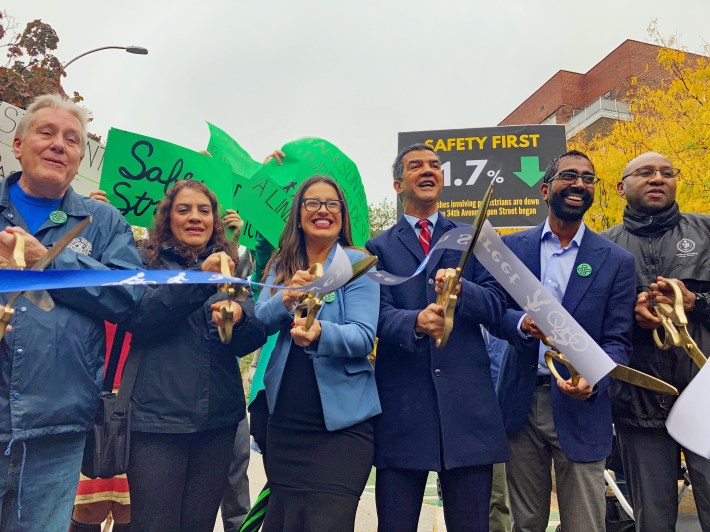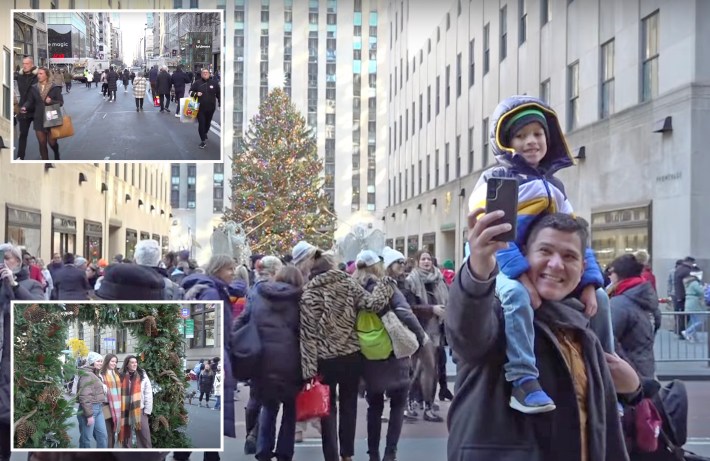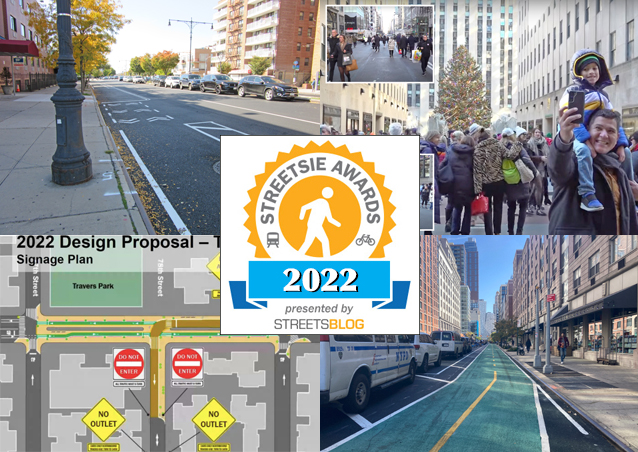
We know we're the first to chide the city's Department of Transportation for limited ambitions, half-finished projects, and frequent capitulations to the car-loving community.
But we would be remiss not to point out that many projects completed this year by DOT's hard-working employees are worth applauding because they helped make the city a more walkable, livable, and safe place.
And the data does prove it. So far this year, overall traffic fatalities have declined by more than 7 percent since last year, and pedestrian fatalities have dropped along with it — success the DOT attributes to its work on the street.
"This success is against the backdrop of the rest of the United States, which has seen pedestrian deaths rise to levels not seen since the 1980s," said DOT First Deputy Commissioner Margaret Forgione during a press conference last week. "We are clearly defying national trends in a big way. How are we doing it? With more street redesign."
So, let's join them in celebrating some of the best projects of the year!
And the nominees are:
24-7-365 speed cameras
Technically, the permission to allow the city to operate speed cameras all day and all of the night came from the state legislature, but it couldn't have gotten there without the city's own lobbying effort.
Yes, Council Speaker Adrienne Adams went on WNYC's Brian Lehrer show in January to say that speed cameras are just a way to nickel-and-dime New Yorkers (despite data proving otherwise), but her position didn't stop the Council from passing what's called a “home rule” message with a vote of 43-7 (here's who voted against it). The legislature then rubber-stamped it.
It wouldn't have happened without DOT's support and campaign proving the cameras save lives and slow down reckless drivers. Commissioner Ydanis Rodriguez not only trekked up to the state capitol multiple times to meet with legislators to push for the expansion, but he also rallied with advocates and spoke passionately in support of speed cameras.
“To anyone who is still like questioning if we should have speed cameras or not, or where we should have speed cameras, I say, we should have speed cameras everywhere there are crashes,” he said in May, just before the vote.
And since the program's renewal and expansion, they have done their job. Streetsblog reported in September, just a month after they started operating 24-7-365, that the speed cameras have ticketed 70 percent more drivers. We followed up in November, too.
More important than the number of tickets being issued is that speeding in November is already down roughly 25 percent from its August high when the cameras first went 24/7, which confirms what DOT has long said: once drivers get a ticket, they rarely get another.
Paseo Park
There remains a tiny pocket of discontent from a small faction of Jackson Heights residents — these are people who didn't even want the city to ban cars on the block for Halloween so kids could safely trick-or-treat — but the city transformed 1.2 miles of 34th Avenue between Junction Boulevard and 69th Street into car-free public space.
Officials cut the ribbon on Paseo Park back in October, when it was already clear that it was a success, and it's no wonder it's referred to as the gold standard of open streets.

Streetsblog reported at the time that traffic crashes plummeted not only on 34th Avenue but also in the surrounding whole square-mile area from north of 32nd Avenue to south of 37th Avenue and from Junction Boulevard to the BQE. Between October 2012 and September 2020 — just before the open street became permanent, car drivers killed 14 people. But in the last two years, there hasn’t been a single traffic death in this area.
And not only did it facilitate a drop in deadly crashes, but those without injuries too. Between October 2012 and September 2020, there was an average of 90 crashes every month in the same square mile area. Since September 2020, that number has dropped to 51 per month, a decline of 43 percent, Streetsblog reported.
And above all, an open-space-starved neighborhood got a linear park. That's a huge project.
Schermerhorn Street

After years of complaints about a notoriously lawless stretch of roadway in Downtown Brooklyn, the DOT finally listened and announced plans to redesign Schermerhorn Street. To combat the drivers — many of them cops from nearby Transit Bureau 30 — who parked in the bike lane, on the sidewalk, in front of fire hydrants, and in crosswalks, the city turned Schermerhorn into a one-way street and added a two-way projected bike lane. Instead of a dangerous, chaotic mess for pedestrians and cyclists who used the crucial corridor, the strip is the definition of traffic calming.
In October, the DOT, pols, and advocates snipped the ribbon and took a well-deserved bow.
Fifth Avenue open street
Following years of painfully overly crowded streets near the famed Christmas tree in Rockefeller Center, Mayor Adams announced that he was making Fifth Avenue car-free for three Sundays during the holiday season. For the first time ever, the city banned cars along 11 blocks of Fifth Avenue to make room for the throngs of pedestrians and tourists that flock to the area, but only three Sundays. Nonetheless, the people loved it!

But it didn't stop there, the gift kept on giving — Adams also announced plans to transform the grand boulevard between 42nd and 59th streets into a redesigned roadway that “will prioritize pedestrians, cyclists, mass transit, and the public realm.” Albeit two years late, advocates are thrilled the vision will finally (hopefully) become a reality.
Apolline's Garden
You'd think after a recidivist reckless driver killed a 3-month-old girl last year, community members would all be on board with redesigning the very intersection where she was killed. But that wasn't the case; as typically happens with street safety projects, some neighbors didn't want "their" parking taken away.
Nonetheless, the DOT forged ahead with the crux of the redesign, by removing parking and creating new public space in honor of baby Apolline's memory.
Signs are now up and the granite blocks have finally joined the planters. Seating to come…#PavementtoPlazas #ApollinesGarden #TacticalUrbanism pic.twitter.com/oEmi17WCsS
— Mike Lydon (@MikeLydon) December 6, 2022
Emmons Avenue
In November, the DOT celebrated the completion of a bike lane on Emmons Avenue car-loving Sheepshead Bay, finally achieving something that the neighborhood’s ex-Council member long opposed (fortunately, he was out of the way in 2022 due to a little issue known as tax fraud).
Not only serving as a key connection between Jacob Riis Park and the world-famous Roll-N-Roaster, the new tw0-mile, two-way protected bike lane along Emmons Avenue also links Coney Island to the Jamaica Bay Greenway.
Today we were joined by @BKBPReynoso & advocates for a ribbon cutting on the Emmons Ave #BikeNYC lane in Sheepshead Bay. The 2-mile lane closes one of the most important gaps in #Brooklyn’s waterfront greenway, connecting Coney Island to the Jamaica Bay Greenway. pic.twitter.com/411yBSF6Tl
— NYC DOT (@NYC_DOT) November 19, 2022
Vote for your favorite project here:






